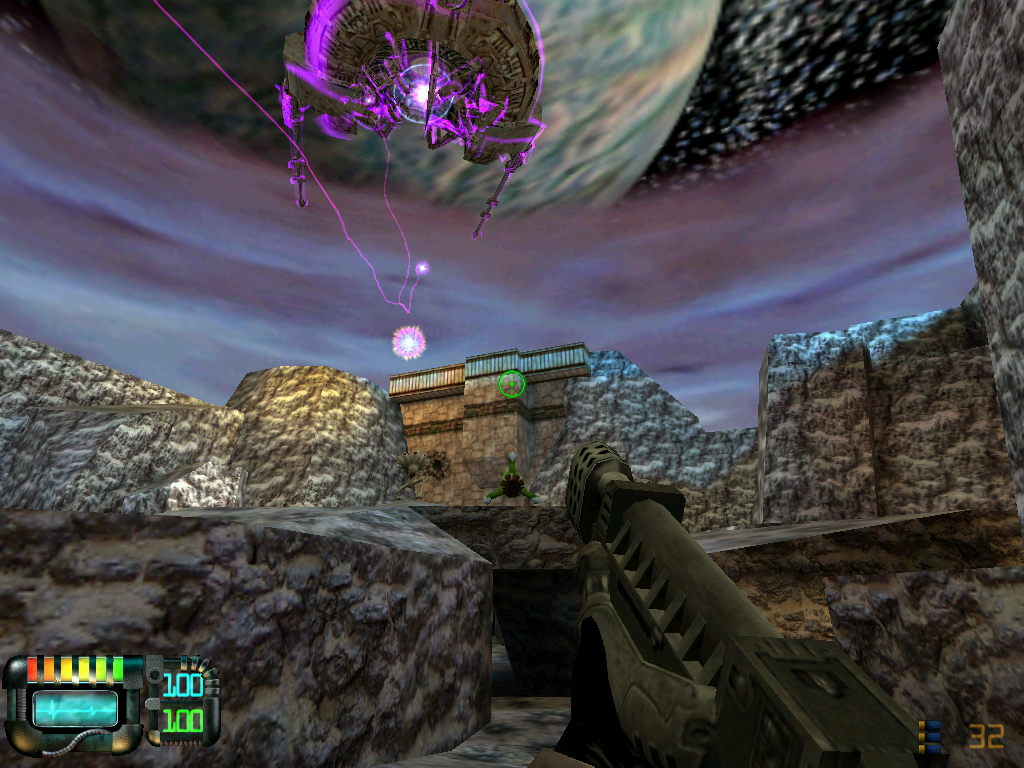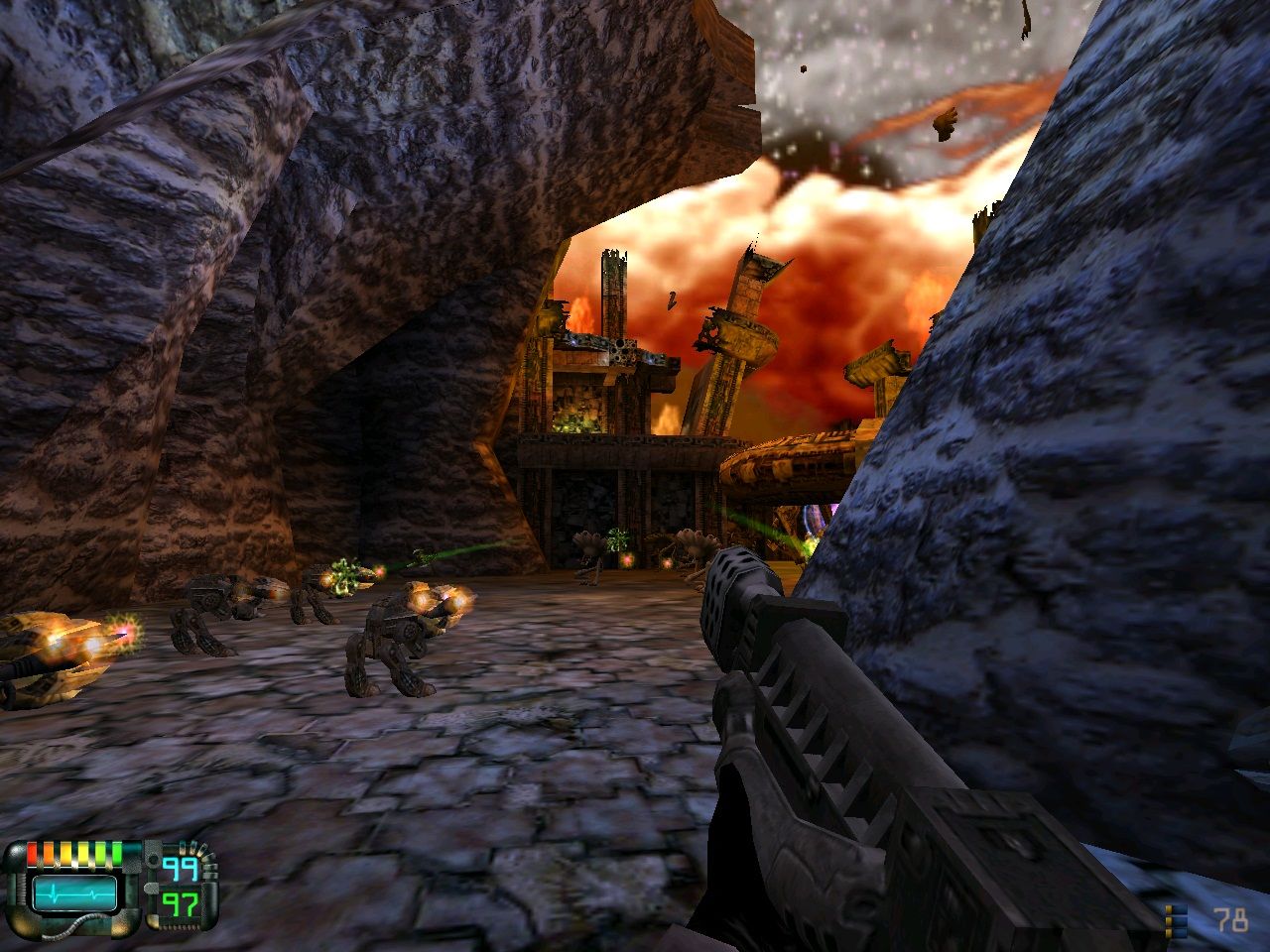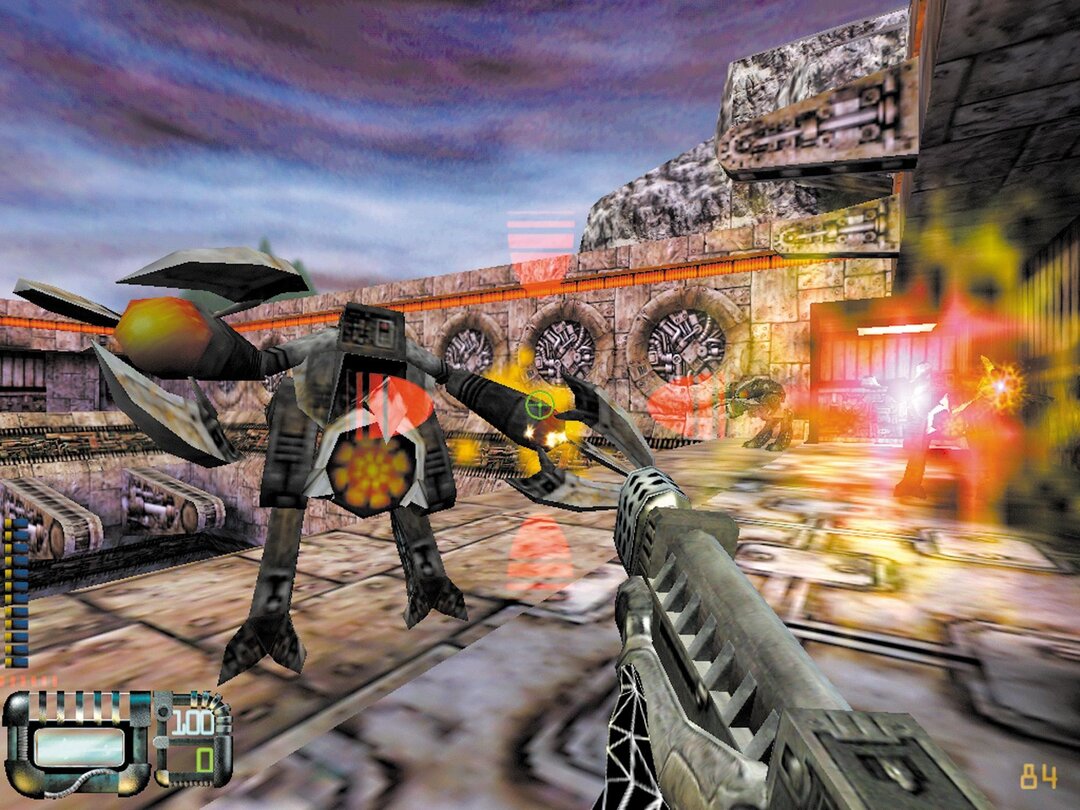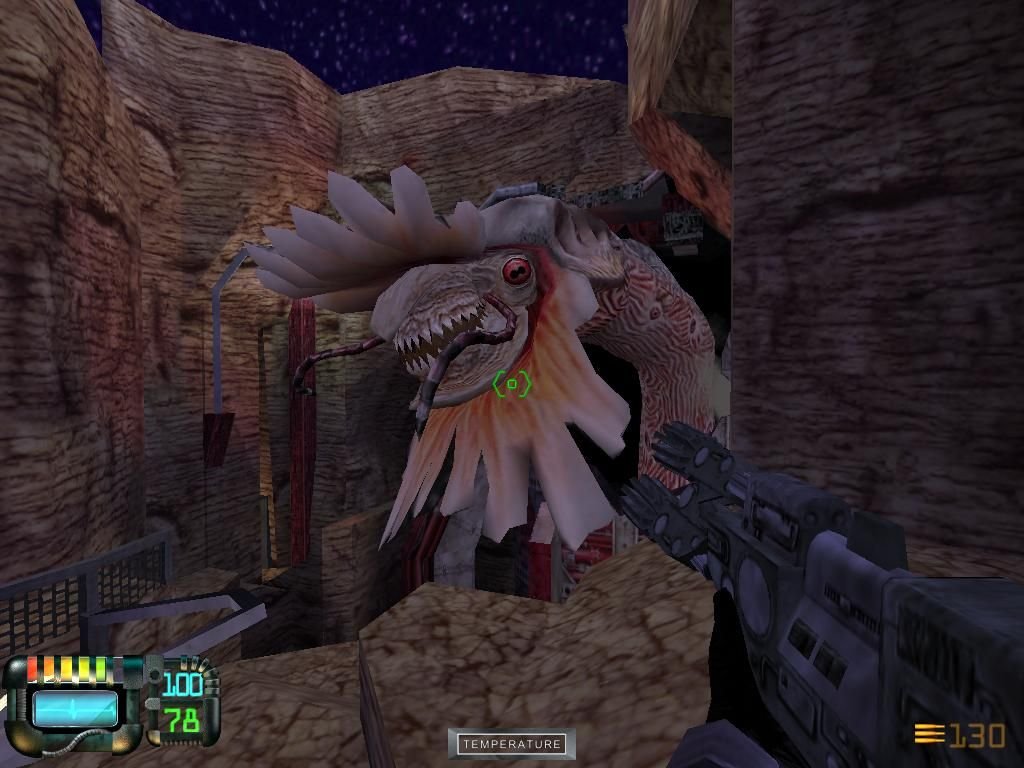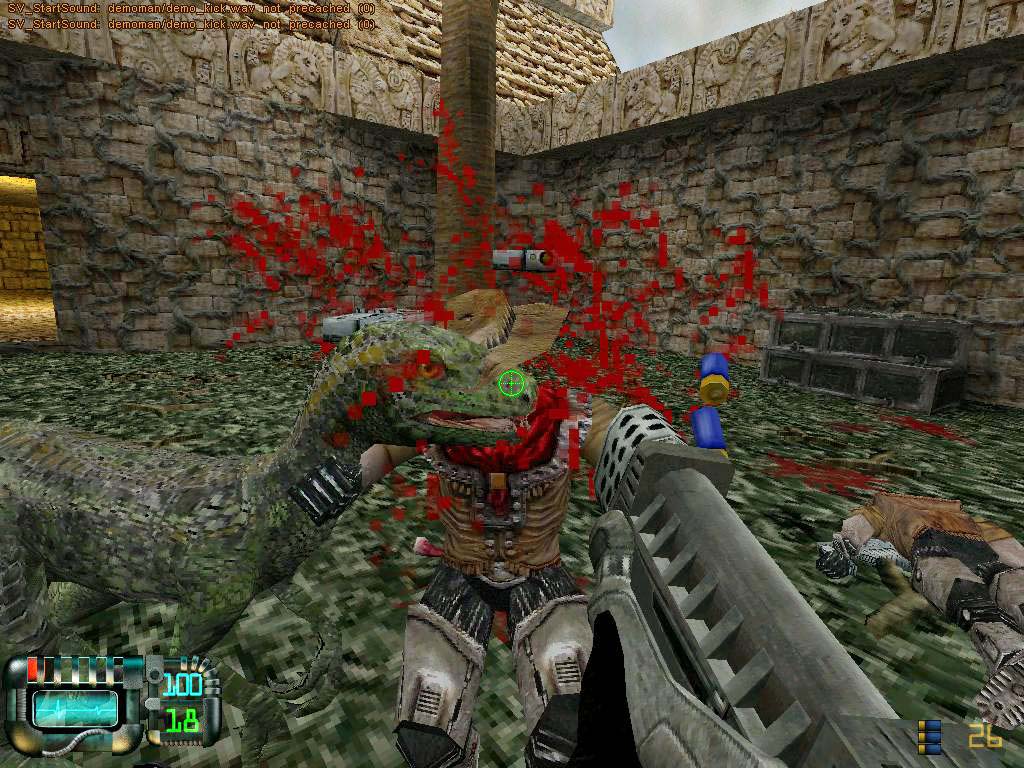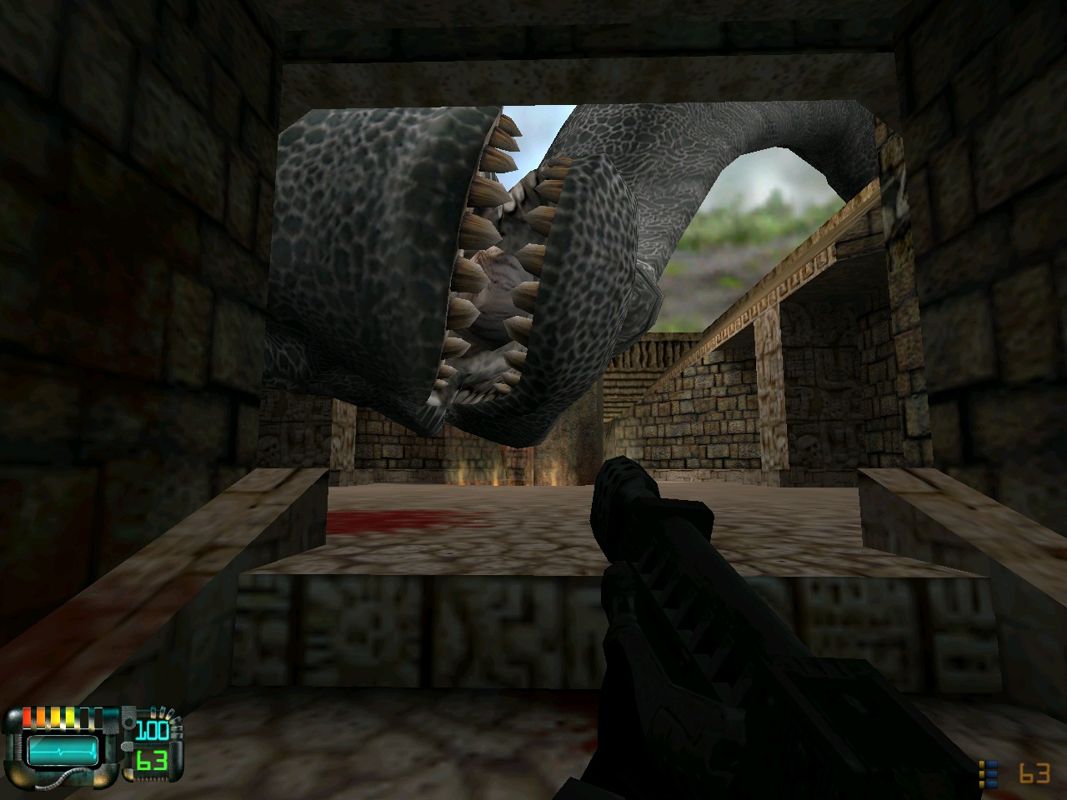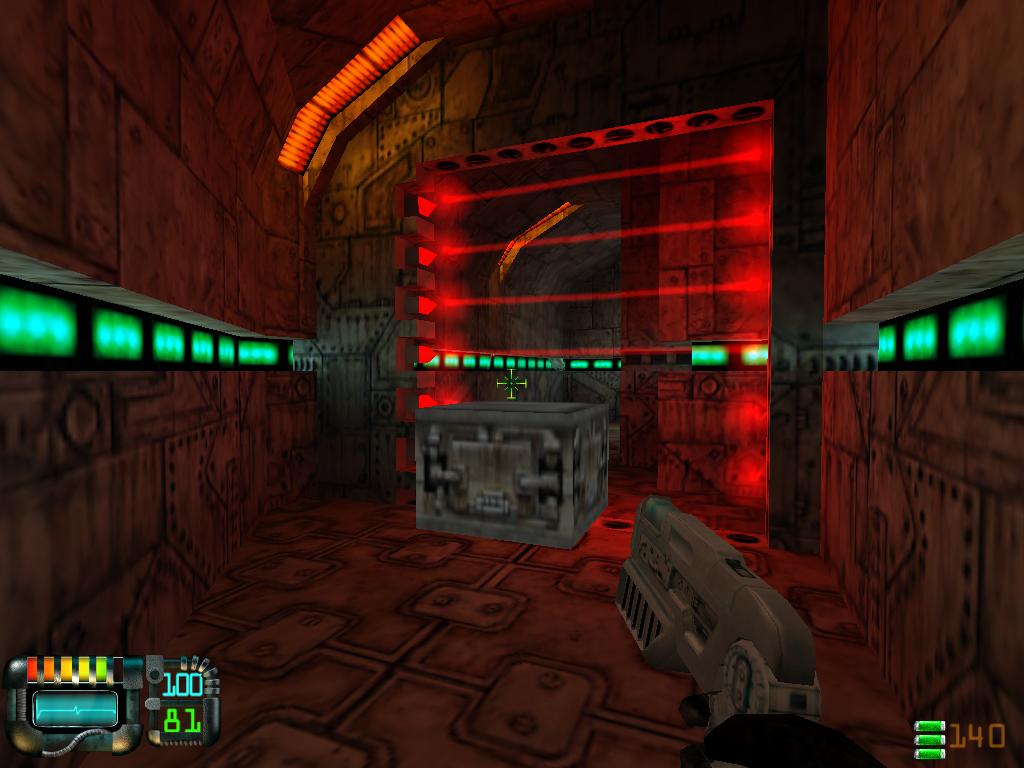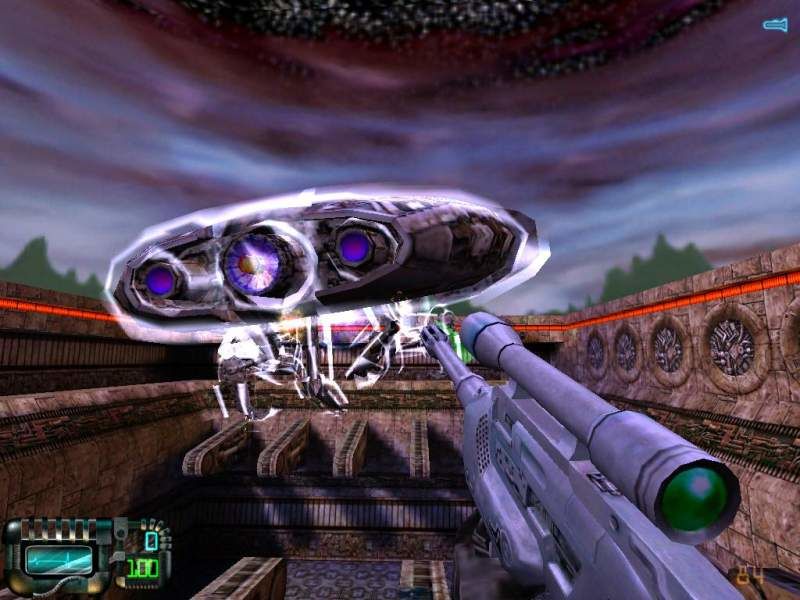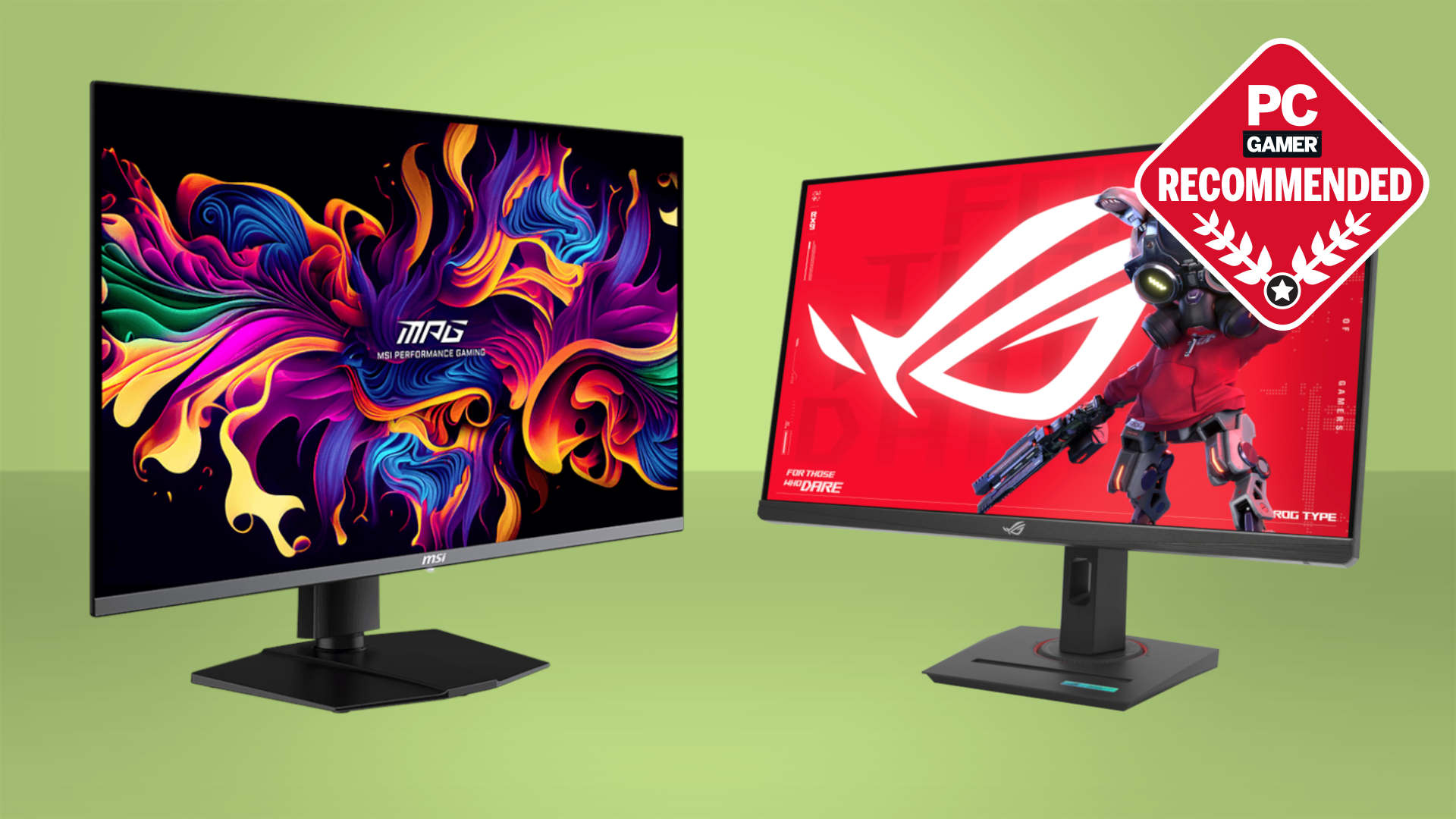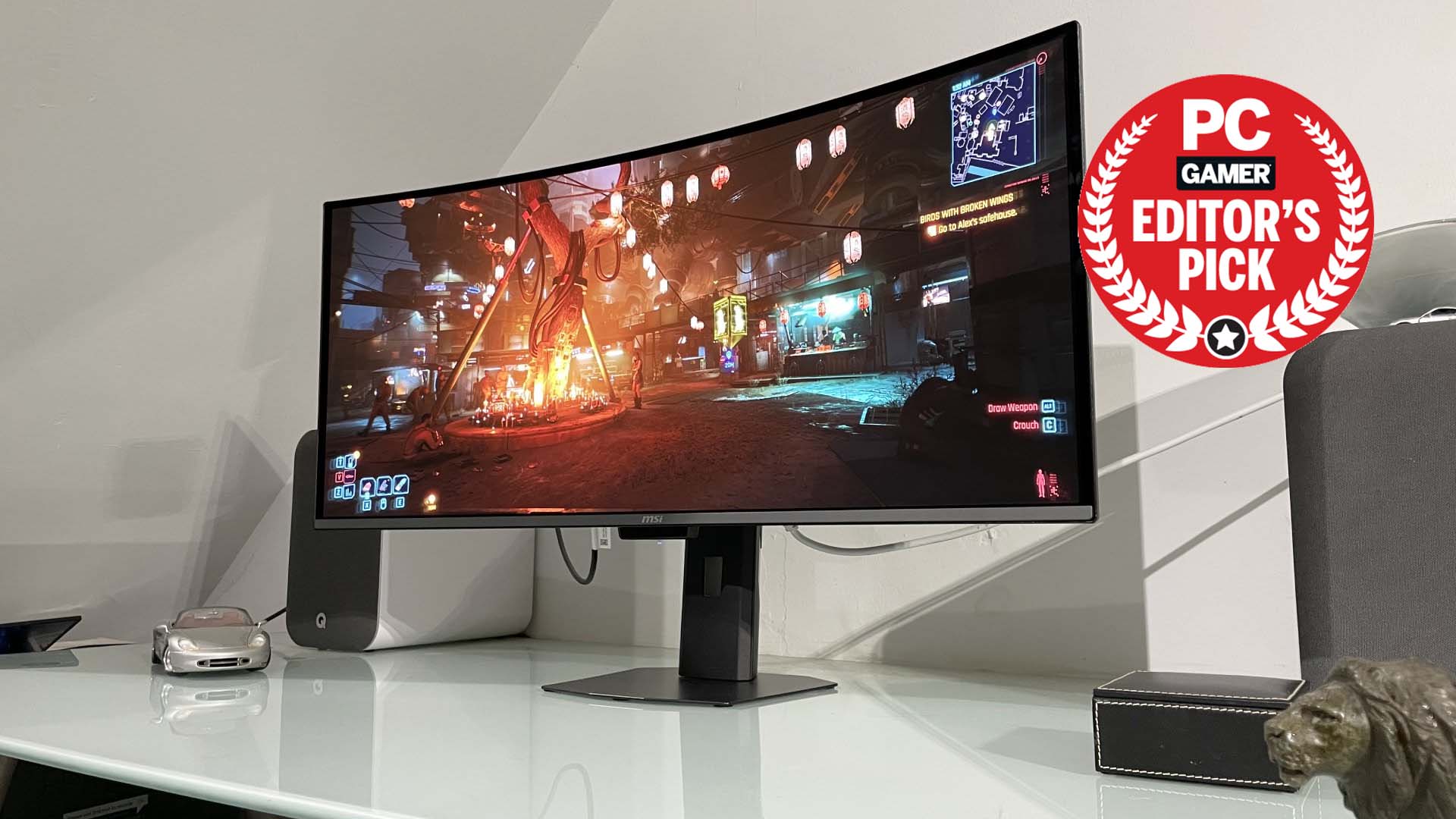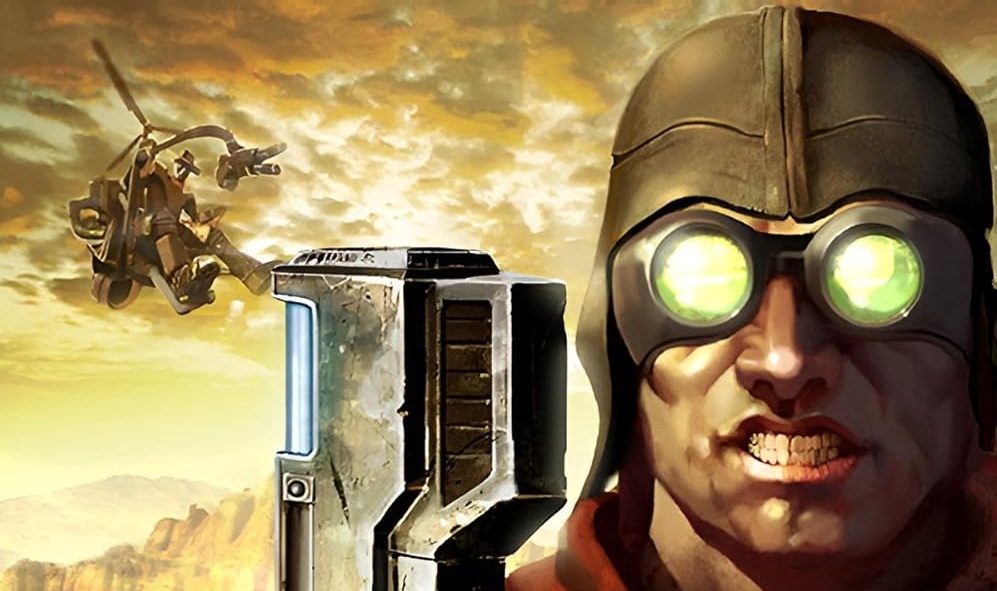
Recently, I was struck by an overwhelming urge to play Gunman Chronicles, the 2000 FPS developed by Valve and Rewolf Software. There was no real trigger for it—this sort of thing happens when you're nearing 40 and grew up on a diet of nineties' shooters. But if I had to identify the origin of this yearning, it would be dinosaurs.
Gunman Chronicles is an ambitious shooter, a gunslinging sci-fi adventure that transports you to a variety of locations and features programmable weapons—a fairly unique gimmick 25 years on. But my favourite thing about it are the dinosaurs. Appearing early in the game, Gunman's terrible lizards have this wonderful, plasticine look that could have come straight from the workshop of Ray Harryhausen. Also, when you shoot the velociraptors with a shotgun, their heads occasionally explode, and exploding heads of any kind will always endear a game to me.
Yet when I opened up Steam to buy Gunman Chronicles, I discovered that I couldn't. This shooter, which I will repeat was created with Valve's direct involvement, isn't available on Steam. Indeed, it isn't available to buy anywhere.
This got me curious, and after a little digging, I discovered there are other strange elements to Gunman's history. Its co-developer, Rewolf Software, dissolved immediately after the game's release, while its director, Herbert Flower, has only one other video game credit on Mobygames, a special thanks for the 2010 Wii game Hoopworld.
Gunman Chronicles is a bizarre island in Valve's early history, one that I felt compelled to chart. And it turns out the tale of Gunman Chronicles is almost, but not quite, a Cinderella story. To create it, a group of young, ambitious FPS modders went to the ball, creating a game with the support of the biggest name in PC gaming. But when the carriage ultimately turned back into a pumpkin, there was no prince waiting for them with a glass slipper.
Herbert Flower, variously credited as the director and team lead of Gunman Chronicles, who now describes himself as an "entrepreneur", has been fascinated by computers, and the idea of making games for them, as long as they have existed.
"When I was 10, this new thing called computers showed up," says Flower. "I remember my dad took me to an electronic store, and they showed me the Macintosh. And I'm like, 'If you can draw circles and lines and you can move that little mouse pointer around, you could make a game out of this, right?' I was thinking about it the whole time."
Keep up to date with the most important stories and the best deals, as picked by the PC Gamer team.
While Flower's first home console was a Commodore 64, his arrival into game development begins when he acquired an Atari ST. Using this, he made an online BBS game called Thieves Guild with friend and fellow student Paul Witte. "I made the front end for it that would show you graphics, which was kind of neat for a text game. You'd fight a monster and we'd show it to you."
Thieves' Guild is well-regarded among fans of BBS games today, notable for its exceptional art for the time. It didn't make Flower or Witte much money, however. "We should have been charging the players for the maps," Flower says. "Somehow I didn't notice the business problem of selling one when we could have sold 20."
Somehow I didn't notice the business problem of selling one when we could have sold 20.
Herbert Flower
Thieves' Guild was also late to the party. It was released in 1993, when the Atari ST was well into its twilight years and the PC was the hot new gaming machine, propelled to stardom by the launch of Doom. "You started to understand how few limitations there were compared to Ataris and Colecovisions and things like that. You could do so much, and I started getting the idea of modding Doom."
The game that would eventually become Gunman Chronicles started out as a Doom mod. Flower, who worked in an auto body shop, would physically craft his own textures for the mod, importing them into the game using a gadget called a Snappy, which could capture full colour images of video input.
"I would take a piece of cardboard and glue on a whole ton of parts, machine parts and parts from pens and bottle caps," Flower says. "I'd paint it up and make miniature techno walls and cool things." Enemy models were likewise hand-crafted and imported via photographs, similar to how Adrian Carmack created the demons in Doom. "If you want to make a dinosaur, you could just make it out of clay and pose it [and] photograph it."
Through this approach, Flower says he ended up with a Doom mod that was "way better looking than anything on the market". But graphics technology was evolving at lightspeed in the '90s, and like John Romero in his Ion Storm days, Flower found himself drawn to every new engine that came out. He ported his mod to both the Build engine and the Quake engine, before finally settling upon Half-Life's GoldSrc engine as its technical basis.
Through this period, Gunman grew from a solo project to one involving multiple volunteers. Flower says the team were all 16-17 and based all across the globe, with design coordinated via ICQ. Flower dubbed his diffuse studio Rewolf, his own surname spelled backward. "One of the guys, Raniere [Banninga], he lived on a boat. His family was from South Africa, and so he would [leave] certain ports, disappear for two weeks, appear at a different port. I actually had to send him a copy of Half-Life." The project also began to formally coalesce as Gunman, though Flower says it was originally titled Gunmanship 101 and was conceived as a PVP shooter, very different from the final, singleplayer experience.
By this point, Flower was running short on money. He'd cut down his work hours to focus on the mod, ultimately moving back in with his parents. "I was poor", he says. "I remember I lost my shoes. My dad put them in a box and I never could find him. And I went to the mall in my mud boots. I felt like a douche." According to Flower, it was around this time that Banninga, Gunman's lead modeller and animator "took matters into his own hands" and contacted Valve. "He approached Valve and said 'Hey, save us'."
And Valve did. Flower says the Half-Life developer gave the Gunman team "20 grand" and a bunch of milestones to meet. Banninga left his parent's boat and moved in with Flower, and they continued developing Gunman, working out of Flower's parent's basement. After "about a year" of working like this, Valve made another offer—to come out to Seattle and work on the game all in one place.
Valve brought the entire Gunman team, which included modders from Italy, Ukraine, and Germany, together in Seattle, with the team living together in two "hotel-type apartments". In the mornings, the team would cram into Flower's "awful little van with iffy brakes" and head over to Valve HQ, where they'd work on Gunman in office space organised by Gabe Newell. "Gabe had rented some space below the main office level in his little office tower, and we had a few rooms," Flower says.
For Flower and the team, it seemed like a dream come true. But Flower was unprepared for Newell's plan to get Gunman finished. "He assigned one of his guys to put the whip to us," Flower says. "We'd get home at two in the morning, back to our apartments, and then go back to work." After a fortnight of this routine, Newell assessed the game's progress. "Gabe's like 'You know what? I think you guys need more than two weeks.'"
We'd get home at two in the morning, back to our apartments, and then go back to work.
Herbert Flower
Rewolf ended up stationed at Valve for two and a half months. Flower says that Newell regularly engaged with the Gunman project, with the pair speaking every day. The extent to which Valve was involved in the design of the project is less clear, however. According to Gunman's Wikipedia, Valve placed Jeff Lane, new to the studio at the time, on the project as a mapper. Flower disputes this, saying that Valve's only personnel contribution was a QA tester the Rewolf team referred to as "The game nazi".
"We loved him. His job was to break your game," Flower says. "He would do things you didn't expect. He was the most valuable thing we ever had from Valve, I'll tell you what, aside from the free caffeine upstairs."
Indeed, while Flower fully understood the opportunity laid out for him and the Gunman team, his time at Valve was not quite the magical experience he'd hoped for. This was partly down to the punishing schedule they had to keep to, but Flower also says that a rift developed between Newell and himself. "My relationship with Gabe didn't really go that great," he says. "It's not like we hated each other. It's like two people with bad breath. We're like 'OK, can't wait to get out of the room with this guy.'"
From his perspective, Flower believes Valve didn't give Rewolf a big enough slice of Gunman's royalties. "Gabe didn't get rich by giving away money," he says. "We had avoided having publishers because we really didn't want to get that 10% of the sale price. We wanted to get more than 10%, and I think we ended up with 11% through Valve."
It's worth specifying here that Valve didn't publish Gunman. This was handled by Sierra Studios, which had also published Half-Life. But Flower says all his agreements were made with Newell, while Valve negotiated with Sierra separately. "Normally, publishers get this huge 90% [of royalties] and Valve just used their power to say 'You get 50%, not 90.' And I was like, 'Awesome, Valve can recoup anything they've invested times whatever, but we'll maybe do OK.' And now we get 11 [percent] or something."
Flower says realising the cut Rewolf would get "threw water on the flame of my soul at that point," particularly when he had to break the news to the Rewolf team. "We hadn't even discussed how we were splitting up the take," he says. "There's a dozen people, and some are more important than others, and like, who wants to hear that they're going to get 4% of 11%? I think I only got 11% myself, and I was the guy running the whole thing and who had no shoes at some point."
I probably could have made as much money painting cars.
Herbert Flower
After two and a half months at Valve, Gunman Chronicles finally went gold, and Rewolf wrapped up its work on the project. "It was anticlimactic," Flower says. "There was no big party. We were burned out, and the team kind of just faded off as they [went] home. [We were] dropping people off at the airport, good friends I might keep in touch with, but never see in person again."
Gunman Chronicles launched on November 21, 2000, and received mixed reviews from critics, which is still a sore point with Flower. "When you see reviews and they're like, 'Oh, this game is too much like Half-Life!' And you're like, 'What, the best game that you ever rated? Too much like that, huh?'" The game sold relatively well, although Flower says he "didn't get rich" off his cut. "I probably could have made as much money painting cars, as far as take-home money. But royalties are taxed at a lower rate, so it spent pretty good."
Gunman wasn't the end of Flower's game development career. After recovering from the burnout induced by the project, he joined back up with his high-school friend Paul Witte to form Mythyn Interactive, creating the Ultima Online-inspired MMO Linkrealms. Unfortunately, the project ended up being as anticlimactic as Gunman, only stretched over a much longer period. "We were just so underfunded and understaffed, two or three people trying to make one of the most complicated pieces of software," Flower says. "I spent 10 years on that project. There's nothing worse than being an entrepreneur and failing slowly."
Flower doesn't know why Gunman Chronicles isn't on Steam, but assumes it has something to do with a rights issue between Valve and Vivendi (which merged with Activision in 2008 to form Activision Blizzard). "I don't know what's going on", he says. "We did, with Valve, say we get first right of refusal if they want to make a sequel, so that we could do it. And some years later we asked 'Hey, would you care if we started fiddling with this kind of thing?' and got a hard 'No, don't do it.'"
While many of Rewolf's developers have gone on to work at other companies in the games industry, Flower is no longer involved with game development directly. Instead, he runs a photogrammetry business creating texture packs for game engines like Unity. The business is named 'Goatogrammetry' after the pack goats that carry Flower's equipment while hiking in the Utah desert. "I love to explore the world, right? Go out in the desert. I'll take my packing goats, the German Shepherd, and just, you know, you go out and you see this stuff," he says. "Nothing like going on a hike and coming back with 100 bucks' worth of photographs."
Rick has been fascinated by PC gaming since he was seven years old, when he used to sneak into his dad's home office for covert sessions of Doom. He grew up on a diet of similarly unsuitable games, with favourites including Quake, Thief, Half-Life and Deus Ex. Between 2013 and 2022, Rick was games editor of Custom PC magazine and associated website bit-tech.net. But he's always kept one foot in freelance games journalism, writing for publications like Edge, Eurogamer, the Guardian and, naturally, PC Gamer. While he'll play anything that can be controlled with a keyboard and mouse, he has a particular passion for first-person shooters and immersive sims.
You must confirm your public display name before commenting
Please logout and then login again, you will then be prompted to enter your display name.
